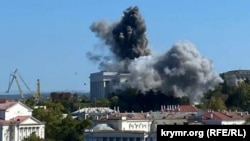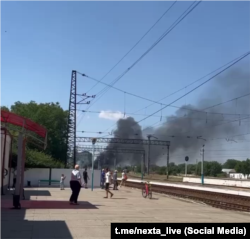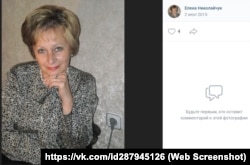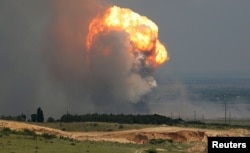On September 22, Ukraine carried out a deadly drone strike targeting the headquarters of Russia's Black Sea Fleet in the center of the Crimean port city of Sevastopol. Local retiree Olena Nikolaychuk by chance caught the explosions and the immediate aftermath on video as she walked through the Russian-occupied Ukrainian city.
She shared the video with some friends, and eventually it made its way to social media. The video was then used by numerous Ukrainian and international media outlets covering the audacious attack, which reportedly killed or wounded dozens of officers.
Two weeks later, Nikolaychuk appeared in a video on a pro-Russian Telegram channel in which she apologized for her "actions."
"I regret what I did and think it was wrong," she says, sitting alone against a wall and speaking monotonously. "Believe me when I say I will never do this again. I don't need such problems at my age, such unpleasantness. Forgive me."
"The extent of her guilt will be determined by the comrade major," the text accompanying the video reads, using the channel's nickname for its own activists.
As the Russian invasion of Ukraine continues, the Black Sea peninsula of Crimea, which Russia invaded and occupied in 2014, has increasingly seen attacks targeting Russian military supply lines and the Black Sea Fleet. The Russian-installed occupation authorities have repeatedly warned people against posting on social media about attacks, the effects of which official media routinely minimize.
"Remember that posting videos of military facilities or critical infrastructure helps the enemy," Oleh Kryuchkov, an aide to the head of the occupation administration in Crimea, posted on Telegram in July, adding that citizens should identify people who do such things to the security agencies.
"Repentance" videos like Nikolaychuk's -- which may be the result of threats or other coercion -- are increasingly being used to drive home these warnings. It echoes the Stalin-era practice of forcing political prisoners, often through torture, to publicly confess their misdeeds at stage-managed show trials.
The Telegram channel that published Nikolaychuk's video is called Crimean SMERSH, using a Stalin-era portmanteau for the Russian phrase "Death to spies," and bills its posts as "official statements from the law-enforcement organs." It regularly posts real-time videos of law-enforcement raids.
"A register of Russophobes, Ukrainian nationalists, and traitors to the motherland," the channel’s description reads.
RFE/RL was not able to contact Nikolaychuk. An inactive social media account under her name contains only one photograph from 2015. Neither the police nor the Federal Security Service (FSB) have issued any statements about her or the Crimean SMERSH video.
On October 6, Crimean SMERSH published a video of a man identified as Ivan Ivanov apologizing to a truckload of Russian soldiers for allegedly shouting the slogan "Glory to Ukraine!" in Ukrainian. At one point, a person off camera kicks him when he is too slow to state exactly what he is apologizing for. The accompanying text claims the man requested that "comrade major undertake his reeducation."
On August 11, the Telegram channel posted a video purporting to show a woman from the Crimean city of Yalta who allegedly posted photos of pro-Ukrainian yellow ribbons placed around Sevastopol. In the video, she apologizes, says she was "led astray," and promises it would never happen again. The text below the video says she had been "found and de-Nazified" -- a reference to Russian President Vladimir Putin's false claim that Ukraine is permeated by Nazism.
On July 22, a Ukrainian drone attack struck a Russian military airfield near the Crimean settlement of Oktyabrske. The same day, amateur video of the aftermath of the attack appeared on YouTube.
The following day, Crimean SMERSH published a video of two local men, identified as Vitaliy Lopatko and Serhiy Tarasenko, apologizing for making the videos. Lopatko apologized for "offending those who are defending us" and advised others not to follow his example.
It is impossible to ascertain the circumstances under which these videos were made, but others who have been similarly filmed by the Russian-imposed authorities in Crimea have said they were coerced.
In March, Bohdan Ziza, a resident of the Crimean city of Yevpatoriya, told RFE/RL's Crimea.Realities that FSB agents had forced him to record a repentance video, which was shown on state-controlled local television. He was accused of throwing yellow and blue paint on the façade of the local administration building in an apparent pro-Ukrainian gesture and charged with terrorism.
"There are at least five versions of my 'apology' video," he said. "The first was used by the media, a second was made for my case file, and there were several other rejected takes. They were filmed directly by the FSB officers. First they calmly tell everything you have to say on camera. But when you refuse, they begin threatening you."
After the first video was recorded, Ziza said, the officers sent it to their superior officers for review. He was then forced to make a second video because, he said, the officers felt he "wasn't sufficiently sincere" in the first one.
"I deliberately didn't show any emotion, so they beat me again," Ziza recalled. "The text was constantly changing. First, I needed to apologize to the Russian Army and then, to Putin personally. In the end, they realized the latter part wasn't necessary."
Ziza said that, in his experience, "almost every political prisoner in Crimea is subjected to beatings and torture."














